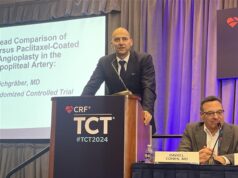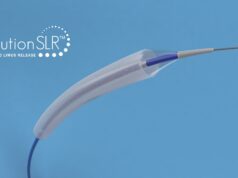
A pooled analysis of four randomised controlled trials finds drug-coated balloon (DCB) angioplasty superior to plain angioplasty in patients with femoropopliteal artery disease, irrespective of their demographics, cardiovascular risk factors, comorbidities or lesion characteristics. This conclusion was recently published in Cardiovascular and Interventional Radiology by Thomas Albrecht (Vivantes Klinikum Neukölln, Berlin, Germany) and colleagues.
Whilst this pooled analysis looked primarily at late lumen loss, it also evaluated secondary endpoints, such as target lesion revascularisation, amputations and all-cause death at 24 months. The rate of target lesion revascularisation was significantly lower in the drug-coated balloon group: 16.3% compared to 40.4% in the plain angioplasty arm (p<0.001). There was no significant difference in amputation rate between the two groups: 2.3% for the plain angioplasty treated patients vs. 2.8% in the paclitaxel-coated balloon cohort (p=0.742).
Most importantly, there were no significant differences in all-cause death rates at 24 months between the plain angioplasty and the drug-coated balloon groups (5.5% and 7.9% respectively; p=0.317).
A recent meta-analysis by Konstantinos Katsanos (Patras, Greece) et al, published in the Journal of the American Heart Association, had contradictory conclusions, reporting an increased risk of death at two and five years following the use of paclitaxel-coated balloons and stents in the femoropopliteal artery.
Whilst the Katsanos study followed patients through to five years, this pooled analysis provides results obtained just two-years post-intervention. However, this present study does offer patient-level data, where the Katsanos meta-analysis did not, and Albrecht believes this at least partially accounts for the different findings.
Explaining these contradictory results, Albrecht elucidates: “We did not see a significant influence of paclitaxel coated balloons on mortality [like Katsanos et al did]. The big advantage of our study is that we had the original individual patient data available for our analysis. This is particularly relevant with regards to patients lost to follow-up, since most published papers used by Katsanos [and colleagues] do not report on how they dealt with these patients—many of which may have died. Furthermore, our cohort is homogenous, consisting only of patients treated with drug-coated balloons and a paclitaxel dose of 3mg/mm2, while Katsanos included drug-coated balloons with different paclitaxel dosages and paclitaxel-eluting stents with very different drug release properties.”
Of the future of paclitaxel-coated devices, Albrecht is cautiously optimistic, admitting that further investigations are needed, but also emphasising the historic safety and efficacy of these drug-coated devices. He says: “Paclitaxel-coated technologies have been proven to be highly effective in reducing the rate of restenosis in the superficial femoral artery and the popliteal artery, so far with virtually no side effects. The report of Katsanos et al on increased mortality needs to be taken seriously, despite methodological flaws. We will have to review the original data of the previous studies carefully to assess if the observation can be confirmed or not. The future of the field will be dependent on the results of these analyses.”
Katsanos also said that his findings necessitated further investigations into these commercially available devices.
The pooled analysis finds angioplasty with drug-coated balloons superior to plain angioplasty
Albrecht and co-authors surmise that “Our results suggest that all patients and lesions benefit to a similar degree from the use of drug-coated balloons. Drug-coated balloon percutaneous transluminal angioplasty should therefore be preferred to plain balloon angioplasty in all patients with steno-occlusive femoropopliteal lesions of the superficial femoral artery and popliteal artery, irrespective of lesion types and patient risk factors or comorbidities.”
Six-month angiographic data from 355 patients across the THUNDER, FEMPAC, PACIFIER and CONSEQUENT trials were pooled to assess the impact of patient, lesion and procedural characteristics on late lumen loss. All four studies were designed, organised and analysed by the same core research group and recruited patients between 2006 and 2016 in several German centres. All the balloons used across these trials were coated with the same dose of paclitaxel (3µg/mm2).
Intra-study comparisons of baseline data did not reveal any statistically significant differences, meaning the patient cohorts and lesions treated in all four trials were comparable.
Late lumen loss significantly lower after drug-coated balloon angioplasty
“Mean late lumen loss was highly dependent on the treatment used”, the authors write, concurring with earlier published results finding that late lumen loss was significantly lower after drug-coated balloon angioplasty compared to after plain angioplasty.
Albrecht tells Interventional News that these positive results for drug-coated balloons are expected. “On the whole,” he says, “we expected these results. In clinical practice, we have treated all different kinds of patients and superficial femoral artery/ popliteal artery lesions—including calcified ones—with drug-coated balloons for many years, with apparently similar results. Our study confirms this clinical impression, which is very reassuring.”
Patient variables did not affect late lumen loss in the drug-coated balloon arm of this analysis. Notably, the authors report no negative effect of diabetes or coronary artery disease on angiographic outcomes following drug-coated balloon use, contrary to previous reports. The results are in accordance with previous research by John Laird (Adventist Heart & Vascular Institute team, St Helena Hospital, St Helena, USA) and colleagues, who also found no significant impact of patient gender, age, diabetes or Rutherford stages on primary patency in their subgroup analysis of the INPACT SFA study.
The only lesion characteristics that impacted late lumen loss were lesion length and bail out stenting: late lumen loss increased with lesion length in both treatment groups, but drug-coated balloon use outperformed plain angioplasty in any lesion length category. Bailout stenting did not improve late lumen loss in the drug-coated balloon group, but did so in the plain angioplasty group.
Albrecht and colleagues could not account for the fact that their pooled analysis detected a lower late lumen loss in smokers within the drug-coated balloon group (0.10±1.05; p=0.02), saying this finding is “counter-intuitive” and, given the sufficiently balanced groups (61 smokers were included in the analysis and 100 non-smokers), “appears to be a finding to be explored further.” Regardless, both smokers and non-smokers experienced lower late lumen loss when amongst the drug-coated balloon patient population compared to the plain angioplasty one.
Study limitations
Albrecht and colleagues acknowledge several limitations of their pooled analysis. Firstly, they say their study was “a post hoc subgroup analysis of prospectively collected data over a considerable time span which coincided with the overall learning curve to use drug-coated balloons.”
Furthermore, the authors note that different drug-coated balloons were used in three of the four pooled studies. In THUNDER and FEMPAC, the device used was a Cotavance prototype (Bayer Schering/ Medtronic). In PACIFIER, the InPact Pacific (Medtronic) was under investigation, and the SeQuent Please OTW (B Braun) was studied in the CONSEQUENT trial. However, Albrecht et al add that each of the individual studies showed a significant reduction in late lumen loss, irrespective of the device used.
A third limitation identified by the study investigators is the use of a binary scoring of lesion calcification, and finally, the authors understand that the follow-up is constrained to six to eight months’ post-intervention.













